 Vampire Weekend's Surprising Jewish Stories
Vampire Weekend's Surprising Jewish Stories
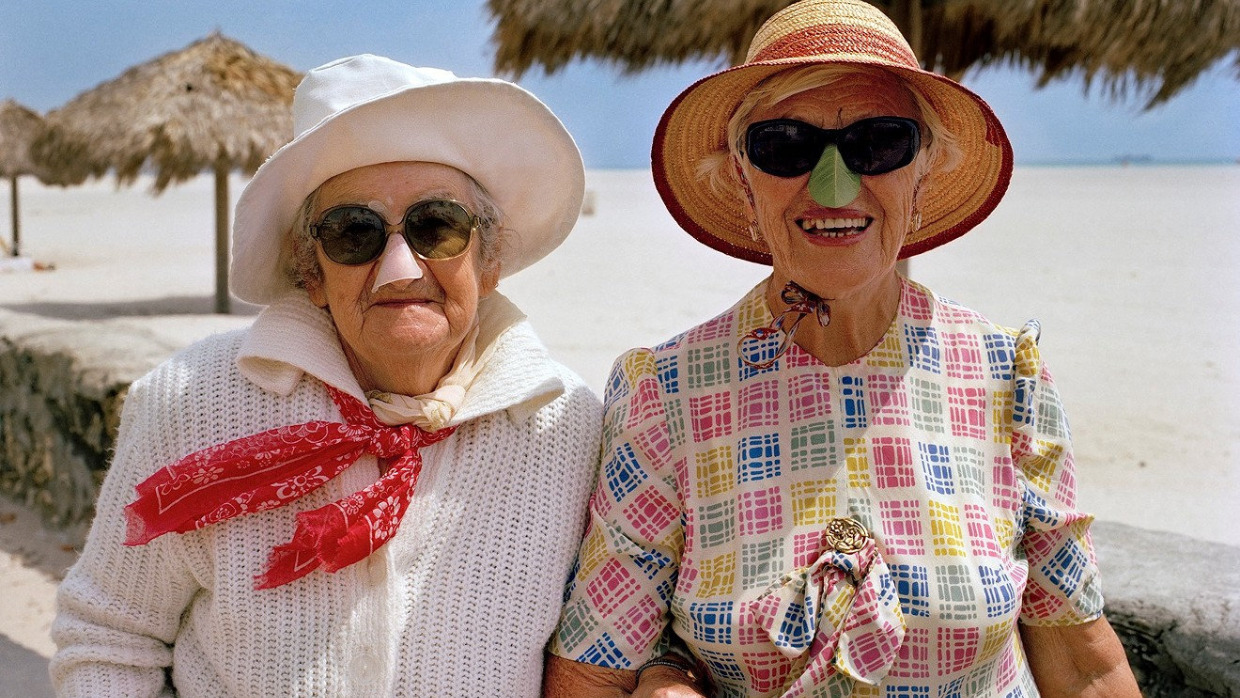

16 min read
How did South Florida become one of the largest Jewish communities in the world?
The Jewish population of South Florida is about 650,000. It has the third largest concentration of Jews in the country and the single largest concentration of Jews (13 percent of the total population of South Florida) outside of Israel.
The story of Florida is a surprising one, with visions becoming dreams and antisemitism in places we would not have expected. Here is the history of one of the most popular Jewish vacation spots, which houses growing and vibrant communities in Dade, Broward, and Palm Beach counites.
In 1513, Juan Ponce de León discovered Florida for Spain, making it the first of the American territories to be discovered and settled. Under the Spanish Inquisition, only Catholics could live in Florida, although it is believed that Jewish Conversos were among the early settlers and soldiers of St. Augustine.
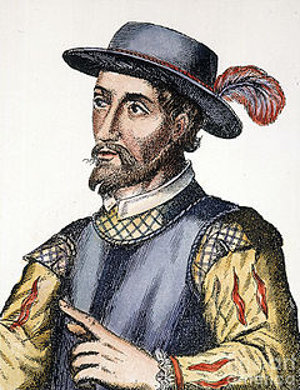 17th century engraving of Juan Ponce de León
17th century engraving of Juan Ponce de León
Under the Treaty of Paris in 1763, England acquired Florida from Spain and Jews could reside there. The first-recorded Jews to settle in Florida, Alexander Solomons, Joseph D. Pallaccios, and Samuel Israel arrived in Pensacola.
More Jews moved to northern Florida over the next few decades, though the Jewish population still comprised of only a dozen individuals.
In 1783 England returned Florida to Spain. Once again under the rule of the Inquisition, Spain ordered a census that revealed Jews, including a Polish Jew, David Moses, who had a hide store in St. Augustine. Remarkably, Spain decided to allow the few Jews to remain as the area needed settlers.
Florida became an American territory in 1821, and between 30 and 40 Jews lived in the northern part of the state.
Samuel Myers, a lawyer, settled in Pensacola in 1821. In 1822, his wife Louisa gave birth to Virginia Myers, the first documented Jewish child born in Florida.
Moses Elias Levy was born in Morocco in 1782 to an influential Jewish merchant who served in the sultan’s court. Levy was fluent in five languages and was a man of many talents. He was a successful merchant, a social activist, an abolitionist, and supporter of universal education.
In 1818, Levy began work on an ambitious project. His vision was to create a Jewish settlement that would give oppressed Jews from Europe an agrarian community where they could freely practice their religion and preserve their culture.
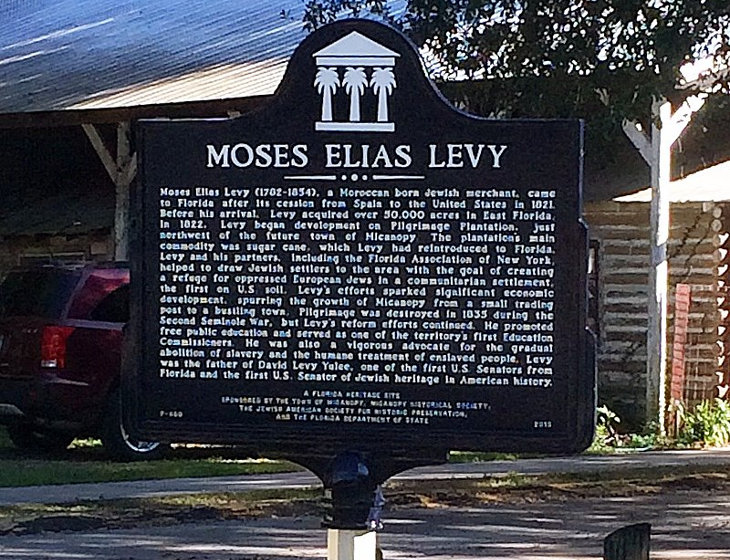 Historical roadside marker, Micanopy, Fl. (Photo by Jrryjude - Own work, CC BY-SA 4.0, https://commons.wikimedia.org/w/index.php?curid=62973168 )
Historical roadside marker, Micanopy, Fl. (Photo by Jrryjude - Own work, CC BY-SA 4.0, https://commons.wikimedia.org/w/index.php?curid=62973168 )
He purchased over 50,000 acres from in 1820 in Alachua County in Northern Florida, which eventually grew to 100,000 acres. He constructed three properties: A sugar cane plantation on the Matanzas River, the Hope Hill plantation in present-day Astor, and Pilgrimage, a few miles from Micanopy. Levy’s dream started to come to fruition in 1823 when his business partner, Frederick Warburg, arrived with 21 settlers.
However, the community only lasted 13 years until the Second Seminole War broke out in 1835. At that point, the community dispersed.
Although it was a financial failure for Levy, it was successful in that it was the first Jewish farming settlement in the United States and created possibilities for persecuted Jews from Europe. The Jewish colony he built in Micanopy is today home to the University of Florida. In an interesting turn of history, this University has the largest Jewish population of any public university in the United States.
On March 3, 1845, Florida became the 27th state of the United States. Out of a population of 66,500, there were fewer than one hundred Jews lived living there.
 A 1591 map of Florida by Jacques le Moyne de Morgues.
A 1591 map of Florida by Jacques le Moyne de Morgues.
Yet their numbers did not diminish their influence. Moses Levy’s son, David Levy Yulee served as the first US Senator from Florida, making him the first Jew to serve in the US Senate. He is known as the Architect of Florida Statehood, since he helped write the state’s Constitution, and he also organized the first cross-state railroad in 1853.
Even his very name continues to be connected to the state. Levy County, on the Gulf Coast in the Northwest Florida, and the town of Yulee in Nassau County, are both named in David Levy Yulee’s honor.
 David Levy Yulee
David Levy Yulee
In the second half of the 19th century, Florida’s Jewish population continue to slowly grow, and Jacksonville was at the center of that growth. It was there that a Jewish cemetery, the first Jewish institution in Florida, was established in 1857, and the first synagogue was formed in 1876. By 1900, six congregations had been established in Northern Florida.
South Florida’s Jewish community lagged behind the Northern and Central Florida Jewish communities for decades. In 1928, roughly 40 percent of the Jewish population of 10,000 lived in Jacksonville. Yet, in the second half of the twentieth century, Jews moved south and began to build communities in Miami and Miami Beach, and then they spread to Broward County, and Palm Beach County.
The primary reason for the small Jewish population in South Florida was the very visible antisemitism.
It was common to see signs in Miami and Miami Beach that read “Gentiles Only” or “No Jews or Dogs.” Wealthy and influential developers, including Highway builder and Entrepreneur Carl G. Fisher’s refused to serve Jewish customers and Oil and Railroad Mogul Henry Flagler (1830-1913) prohibited land sales and hotel lodgings to Jewish clients.
By the 1930s, advertisements for some of Miami Beach's oceanfront hotels said, "Always a view, never a Jew."
In Miami Beach, Jews were only permitted to live south of Fifth Street, as developers placed restrictive covenants in their land deeds prohibiting the sale of Miami Beach lots to Jews north of Fifth Street. Resourceful Jews did purchases modest hotels and apartments on property south of Fifth Street, but the overall feeling was of antisemitism.
The discriminatory laws began easing up in the 1930s and officially ended in 1949.
The first Jew to arrive in Miami was Samuel Singer, who migrated from northern Palm Beach in 1895.
By 1896, Jews owned 12 of the 16 businesses in the pioneer town of Miami, and the Jews held religious services in Miami that year. Yet, when the city was damaged by fire and struck with yellow fever epidemic, the community fell apart. By 1903, the Jewish population declined to one person: Isidor Cohen.
 Three Jewish men, Miami, 1898. Isidore Cohen (center) is believed to be the first permanent Jewish resident of Miami. State Archives of Florida.
Three Jewish men, Miami, 1898. Isidore Cohen (center) is believed to be the first permanent Jewish resident of Miami. State Archives of Florida.
In 1904, Isidor Cohen married Ida Schneidman, and when they had a son in 1907, the first documented bris was celebrated in Miami. In 1913, the death of a Jewish tourist forced the still tiny Jewish community of 35 to create the first congregation and a cemetery.
Advertising, combined with abundant land, new roads, automobile, and commercial aviation, created a tourist and real estate boom in Miami in the 1920s. The population of 100 Jewish families exploded to 3,500 Jews during this time of prosperity. Yet, due to the Great Miami Hurricane of 1926, the stock market crash and the failure of five local banks, the city’s population again decreased greatly.
 Miami in the 1930s
Miami in the 1930s
In the mid-1930s, Jewish Miami began a steady recovery. The hotel, banking, and construction industries flourished with the contributions of the Jews. The post-war economic boom brought additional tourists and settlers to Miami, many of whom were Jews. By 1950, there were 55,000 Jews in Miami and in the coming decade, almost ten thousand Jews arrived yearly.
In 1952, Abe Aronovitz became Miami's first (and, to date, the only) Jewish mayor. In 1963, the first two Jews from South Florida were elected to the state legislature, and in 1973, William Lehman (1913-2005) was elected as a Representative in the United States Congress for the first of ten terms. In this period, large groups of Jews began moving to North Miami and North Miami Beach.
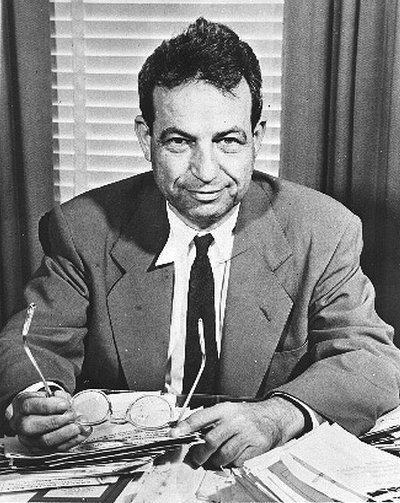 Abe Aronovitz
Abe Aronovitz
Initially Jews were economically based in tourism, building industries or real estate. Eventually, many began moving into medical, legal, and financial professions, and all these trends continue until today.
Despite its reputation for antisemitism in the early 1900’s, Jews started coming to Miami Beach hoping to benefit from prosperity the city had become to be known for.
In the 1930s, restrictive barriers to Jewish ownership of land began to be removed. As a result, large numbers of Jews purchased properties from debt-ridden owners desperate to sell them. The Miami Beach Art Deco buildings of the 1930s and 1940s – many designed, built, and operated by Jews – are architectural treasures.
By the 1970s, almost 80 percent of the population of Miami Beach was Jewish!
In 1949 a law was passed by Florida’s Legislature that ended discrimination in real estate and hotels and development of the Jewish community bloomed. By the 1970s, almost 80 percent of the population of Miami Beach was Jewish!
The Jewish influence on Miami Beach was tremendous. Jews were and are involved politically and in developing the tourist industry. Almost all the museums and arts organizations were started by Jews. Miami Beach has had at least sixteen Jewish mayors, including the father and brother of the former Israeli Ambassador to the United States, Ron Dermer.
Thanks to its beautiful weather, Miami Beach gained popularity as a Jewish winter vacation spot, earning it the nickname of “Shtetl by the Sea.”
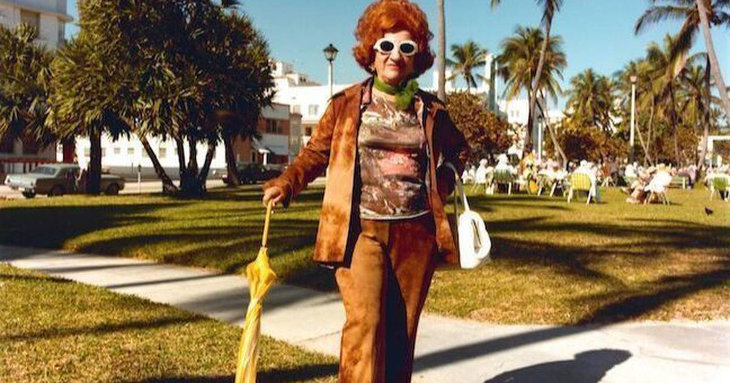
Yet, in 1980, Miami Beach began to change with rising prices and changing demographics. This led many Jews to move north to Broward and Palm Beach counties, and in particular Boca Raton.
Today Miami Beach’s Jewish community has been bolstered by Jewish immigrants from Latin America, Russia, Israel, and Orthodox Jews from the Northeast.
Surfside, which borders on Miami Beach, is currently the area’s most Jewish neighborhood. In fact, of its 6000 residents, it is estimated that almost half are Orthodox Jews.
By 1910, five years before Broward became a county, a Jew named Louis Brown, arrived in Dania, the first of the county's cities. By 1923 seven Jewish families were living in Fort Lauderdale and after a few more families moved there, the first Jewish service in Broward County was held on September 17, 1926.
The building boom in the area went bust in 1926, but the small Jewish community remained. By the second half of the 1930s, the area began to recover. The Jewish community grew as well, and by 1940 there were 1,000 Jews in Broward County. Today the city of Hollywood, in Broward County, has a robust Jewish community.
Few know the fascinating background that a Jewish family is largely responsible for the entire city’s growth.
In the 1920s, Sam Horvitz, a high school dropout from Cleveland, entered a contract to build sidewalks and streets for Hollywood. In the building bust of the late 1920’s, Sam purchased and eventually owned more than half the vacant land in the city. As the owner of over 25,000 lots, Horvitz began building and selling single-family homes.
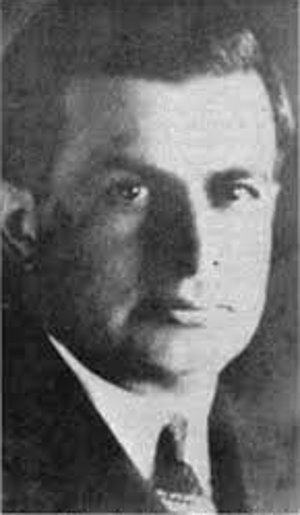 Samuel Horvitz, founder of Hollywood, Inc.
Samuel Horvitz, founder of Hollywood, Inc.
When Sam Horvitz died, his son William took the reins of Hollywood Inc., and continued to build on his father’s vision. The company began extending the city westward, with carefully controlled development adhering to the concept of quality communities. Hollywood Inc. built Orangebrook Golf Estates, Hollywood Hills, Emerald Hills, Lakes of Emerald Hills, Hollywood Mall (the first enclosed mall in Florida), the Bank of Hollywood Hills, the Post Haste Shopping Center, Sheridan Mall, and the Executive Plaza of Emerald Hills.
In 1966 Maynard Abrams became Broward's first Jewish mayor for the City of Hollywood. He was followed by many dozens of Jewish mayors, state legislators, and U.S. Congressional representatives in Broward County.
In the 1970’s, Jewish retirees began choosing Broward as their new home, and moved to retirement communities in west Broward, such as Century Village in Pembroke Pines. The large population of Jews in Broward brought a strong sense of community and Jewish identity. Multiple synagogues opened there. In 1970, there were 40,000 Jews, and in 1990, the Jewish community of Broward peaked at 275,000.
Today Broward County has many thriving Jewish communities, including Fort Lauderdale, Hollywood, Cooper City, Deerfield Beach, Hallandale Beach, Pompano Beach, Tamarac, and Weston. with over 235,000 Jews.
The first known Jewish residents of Boca Raton, Florence, and Harry Brown, arrived in 1931 from St. Louis.
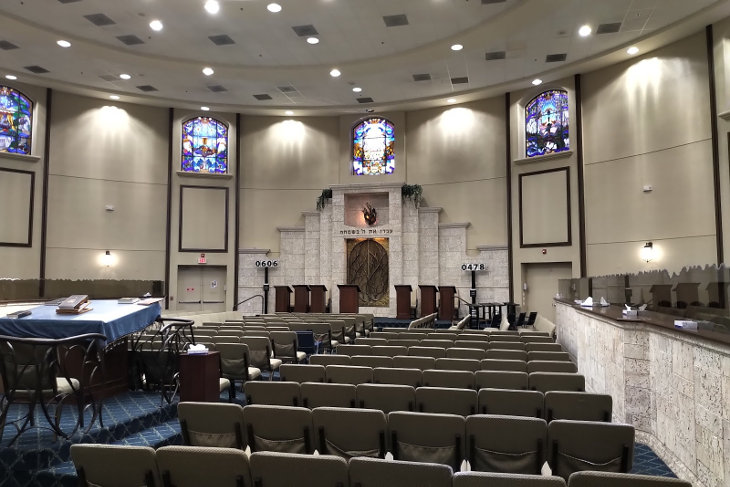 Synagogue in Boca Raton
Synagogue in Boca Raton
Restrictive and antisemitic real estate practices kept the Jewish community small during the first decades of the 1900’s. By the 1960s, the Jewish population began to grow and in 1979, the Jewish population of Boca Raton, Highland Beach, and Delray Beach was estimated at 37,000.
The opening of Interstate 95 through Boca Raton in the 1970s eased the path for Jews from the Northeast to move to south Palm Beach County. Additionally, Jews from Miami and Broward County began moving to Boca Raton in the 1970’s, a trend that continued for the next thirty years.
Today Boca Raton’s Jewish community which started with a single family in 1931, has grown to almost half the city's population. There are approximately 230,000 Jews in Palm Beach County, with very large communities in Boca Raton, Delray Beach, and Boynton Beach.
One of the distinctive communities in Miami is that of Cuban Jews. With the rise of Fidel Castro in 1959, approximately 10,000 Cuban Jews came to South Florida. The foundation they laid, would help Jewish immigrants who followed them integrate into the South Florida Jewish community.
The Miami area currently has the highest proportion of foreign-born Jews of any area in the United States. Jews from Venezuela, Argentina, Columbia, Mexico, and Brazil have settled in Miami area. There are also almost over ten thousand Israelis in the Miami and Hollywood areas.
Recently, there has been an explosive growth of South Florida’s Orthodox Jewish Community.
South Florida is blessed with hundreds of Orthodox shuls and Chabad centers, and dozens of Orthodox schools, and yeshivas. There are over 5000 children in Orthodox schools that benefit from the school-voucher system in Florida. There are advanced learning Kollels, Jewish outreach centers, and numerous kosher restaurants. In the winter, Chassidim from New York, including prominent rebbes and tens of thousands of Orthodox Jews from places like Brooklyn, Lakewood and Chicago visit for days or weeks in South Florida.
Many of the residents and visitors take for granted the thriving Jewish communities and infrastructure that are already in place for them to benefit from.
The truth is that they owe a tremendous debt of gratitude to Rabbi Alexander S. Gross (1917 – March 10, 1980), who played a central role in establishing Jewish life and Torah education in South Florida.
Rabbi Gross was an American Orthodox rabbi who established the Hebrew Academy of Greater Miami, as the first Orthodox Jewish day school south of Baltimore, Maryland. He began the school in a storefront with just six students in 1947.
He was a graduate of Yeshiva Torah Vodaas and a close student of the great Rabbi Shraga Feivel Mendlowitz, the founder of Torah U'Mesorah. Rabbi Gross believed that through giving children a strong Jewish education, he would raise the level of observance and knowledge of the adults as well, and in that way build vibrant and knowledgeable Jewish communities.
Rabbi Gross’s devotion was legendary. He would drive all around South Florida to bring Jewish children to Hebrew Academy, literally driving carpool for multiple families, to help ensure they received the vital Jewish education.
In time, the results of his efforts would be clear to see, as the following vignette demonstrates.
In 1959, due to severe financial strain, the Hebrew Academy of Miami Board of Directors had to institute an austere tuition policy. If parents didn't pay tuition, their child could no longer attend the school. One of the affected families that was in any case not overly enthusiastic about their son attending the Jewish school, told their son Billy that he would no longer be able to attend Hebrew Academy.
Billy was devastated. He loved the Torah studies and the school. Sadly but gratefully, he wrote a handwritten letter to Rabbi Alexander Gross letting him know how much he appreciated what the Hebrew Academy did for him and that he does not have hard feelings towards anyone in the school,
After reading the letter, Rabbi Gross took it upon himself to personally pay his tuition and Billy stayed in the school. He thrived and graduated eighth grade as class valedictorian. He continued his studies in the renowned Telshe Yeshiva in Cleveland and became an accomplished Torah scholar. He returned to Florida as a rabbi and built up the North Miami Beach community. Rabbi Zev (Billy) Leff, is today the rabbi of Moshav Mattisyahu in Israel and a renowned lecturer and author.
After Rabbi Gross passed away, his family was clearing out his desk and found a folder that had "my children" written outside in Yiddish. It was a list of children he personally paid tuition for, so they could stay in the Hebrew Academy and not go to public school.
After building Hebrew Academy, Rabbi Gross looked to raise the level of Torah learning and scholarship in South Florida. Until that point, he had sent his best students out of town to study in the larger yeshivas of the Northeast. In 1974, started the Talmudic College of Florida with the support of Miami Beach philanthropist Moshe Chaim Berkowitz. He brought Rabbi Yochanan Zweig, to serve as the esteemed Rosh Yeshiva and as a result of this step, other yeshivas, Bais Yaakovs, and Kollelim would come to be built in multiple South Florida communities.
Rabbi Alexander S. Gross, like Moses Elias Levy 130 years earlier, had a Jewish vision for Florida. Both of their visions have come true.
Featured Image: Courtesy of HistoryMiami
